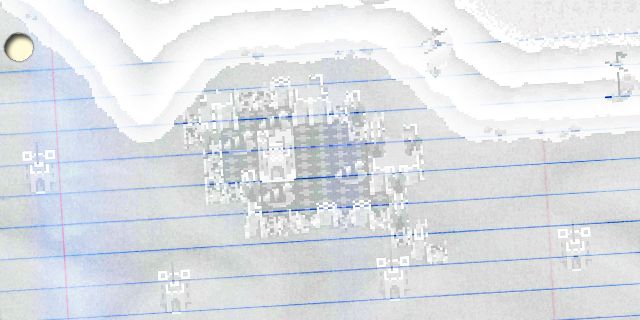
Genre 101 is a series that looks at the past and present of a game genre to find lessons about what defines it. This week, Justin tells us how fending off waves of creeps became a global addiction.
Fortify and survive
 Justin Last: Build your castle, place your cannons, and fend off the unrelenting hordes. 1990 arcade release Rampart ran in phases: “Prepare for Battle”, “Build and Repair” and “Place Cannons.” As an active participant the “Prepare for Battle” round, you shoot cannons at enemy ships and grunts. “Build and Repair” is where castles are built from Tetris-esque blocks, and “Place Cannons” is self-explanatory. It doesn’t feel like what we play today, but Atari’s arcade effort started the defense genre.
Justin Last: Build your castle, place your cannons, and fend off the unrelenting hordes. 1990 arcade release Rampart ran in phases: “Prepare for Battle”, “Build and Repair” and “Place Cannons.” As an active participant the “Prepare for Battle” round, you shoot cannons at enemy ships and grunts. “Build and Repair” is where castles are built from Tetris-esque blocks, and “Place Cannons” is self-explanatory. It doesn’t feel like what we play today, but Atari’s arcade effort started the defense genre.
 Graham Russell: Definitely. It was ignored for a long time afterward, but all the hallmarks of the genre were in place, from the phases to the economic pressures. Why do you think it took so long for another game to attempt something like this? Especially knowing what we do now: that it’s an irresistibly addictive formula.
Graham Russell: Definitely. It was ignored for a long time afterward, but all the hallmarks of the genre were in place, from the phases to the economic pressures. Why do you think it took so long for another game to attempt something like this? Especially knowing what we do now: that it’s an irresistibly addictive formula.
 I think it’s because the genre isn’t well-suited to the arcade environment. Tower defense tend to be a bit more long-winded than other, more successful arcade games like Teenage Mutant Ninja Turtles and Marvel vs. Capcom 2. When home versions were made, they focused on competitive multiplayer, which we still haven’t gotten quite right.
I think it’s because the genre isn’t well-suited to the arcade environment. Tower defense tend to be a bit more long-winded than other, more successful arcade games like Teenage Mutant Ninja Turtles and Marvel vs. Capcom 2. When home versions were made, they focused on competitive multiplayer, which we still haven’t gotten quite right.
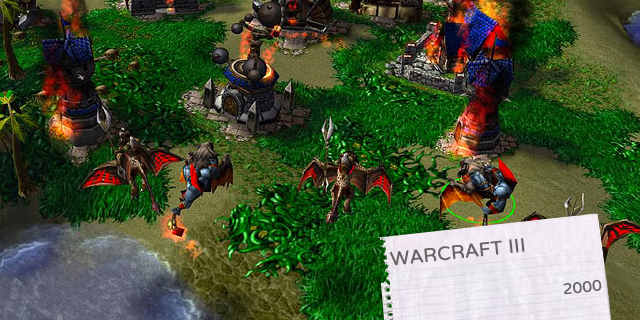
Reborn from the community
 Warcraft III is not a tower defense game, but modern tower defense is born from Blizzard’s real-time strategy offerings. Custom maps like “X Tower Defense” cemented the familiar concepts of tower placement and enemy and tower variety to the genre. Existing as a mod meant that players could get exposed to the genre for free, and try their hand at creating maps and wave layouts of their own. Warcraft III’s custom maps also gave the world Defense of the Ancients, which spawned the MOBA genre. Go go mod tools and an active user community!
Warcraft III is not a tower defense game, but modern tower defense is born from Blizzard’s real-time strategy offerings. Custom maps like “X Tower Defense” cemented the familiar concepts of tower placement and enemy and tower variety to the genre. Existing as a mod meant that players could get exposed to the genre for free, and try their hand at creating maps and wave layouts of their own. Warcraft III’s custom maps also gave the world Defense of the Ancients, which spawned the MOBA genre. Go go mod tools and an active user community!
 You forget when you’re in the middle of things, but yeah, there’s a lot about tower defense that remains similar to a real-time strategy game. Recently, we’ve seen some formulas that take it back in that direction, too. What is it that really distinguishes between the two, from a strategic perspective?
You forget when you’re in the middle of things, but yeah, there’s a lot about tower defense that remains similar to a real-time strategy game. Recently, we’ve seen some formulas that take it back in that direction, too. What is it that really distinguishes between the two, from a strategic perspective?
 For me, it’s being able to see the entire field at all times and really setting up some rules of engagement. In most TDs, I can see where the enemies are spawning and where they’re headed without panning my view. I can also learn the rules. RTS is all about adapting to your opponent’s ever-changing strategy, while tower defense is more of a puzzle. I know, because this isn’t my first run, that the next wave is where air units start, so I’m going to need to set some money aside for anti-air towers. TD lends itself to post-play analysis going for that perfect run, while RTS is more about making the right choices quickly because this time is unique.
For me, it’s being able to see the entire field at all times and really setting up some rules of engagement. In most TDs, I can see where the enemies are spawning and where they’re headed without panning my view. I can also learn the rules. RTS is all about adapting to your opponent’s ever-changing strategy, while tower defense is more of a puzzle. I know, because this isn’t my first run, that the next wave is where air units start, so I’m going to need to set some money aside for anti-air towers. TD lends itself to post-play analysis going for that perfect run, while RTS is more about making the right choices quickly because this time is unique.
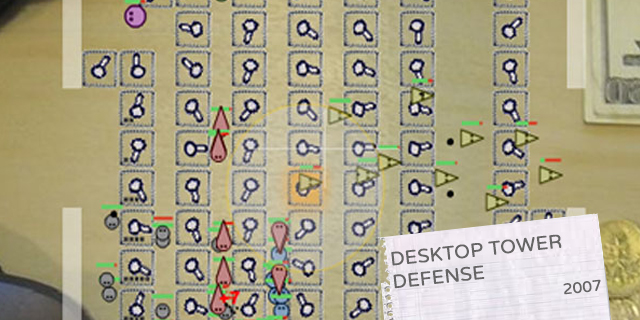
Creating the maze
 Desktop Tower Defense not only reached a wider audience by being available for free online, it also introduced my favorite element of the genre: mazing. The map in Desktop Tower Defense is a completely blank slate. There’s a hole on the left where enemies come from, and a hole on the right where they’re going. Everything between those two points is up to the player. This allows for more strategies, and the dynamic alteration of courses to make tough baddies walk through the same stretch of towers multiple times.
Desktop Tower Defense not only reached a wider audience by being available for free online, it also introduced my favorite element of the genre: mazing. The map in Desktop Tower Defense is a completely blank slate. There’s a hole on the left where enemies come from, and a hole on the right where they’re going. Everything between those two points is up to the player. This allows for more strategies, and the dynamic alteration of courses to make tough baddies walk through the same stretch of towers multiple times.
 There are two distinct mindsets: building an efficient labyrinth and dealing with the path you’re given. Is there a way to mesh the two, and has anyone done it? Or is it a “never the twain shall meet” sort of thing?
There are two distinct mindsets: building an efficient labyrinth and dealing with the path you’re given. Is there a way to mesh the two, and has anyone done it? Or is it a “never the twain shall meet” sort of thing?
 Defense Grid flips balances this well, I think. In mazing-focused levels, the player can choose to let the monsters walk through the open and then get creamed by a few high-level towers instead. Orcs Must Die! (even though it’s more trap defense than tower defense) manages this, as well. Every level I’ve seen is winnable, regardless of whether you take the barricade with you to alter the enemies’ pathing.
Defense Grid flips balances this well, I think. In mazing-focused levels, the player can choose to let the monsters walk through the open and then get creamed by a few high-level towers instead. Orcs Must Die! (even though it’s more trap defense than tower defense) manages this, as well. Every level I’ve seen is winnable, regardless of whether you take the barricade with you to alter the enemies’ pathing.
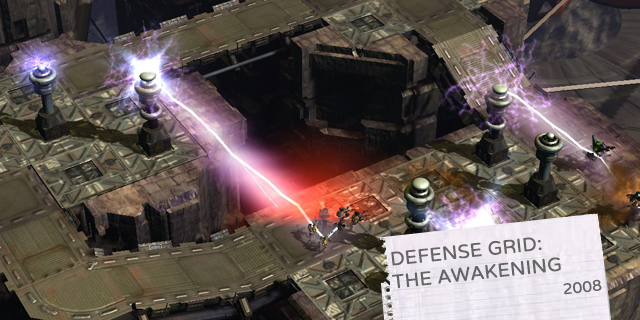
To build or improve?
 After mazing, tower upgrades are the easiest way to allow for differing player strategies. Should I concentrate on creating a complex but weak maze? Or should I spend my resources on fewer but stronger towers? Defense Grid makes you choose, and on open levels that choice is quite difficult. And in more recent titles like Bloons TD5 and Kingdom Rush, an additional choice must be made, because upgrade paths split to form specialist towers. Do I want wizards that teleport enemies backward, or that occasionally kill a single unit regardless of its HP? (You want the teleport; it recharges faster and affects everything.)
After mazing, tower upgrades are the easiest way to allow for differing player strategies. Should I concentrate on creating a complex but weak maze? Or should I spend my resources on fewer but stronger towers? Defense Grid makes you choose, and on open levels that choice is quite difficult. And in more recent titles like Bloons TD5 and Kingdom Rush, an additional choice must be made, because upgrade paths split to form specialist towers. Do I want wizards that teleport enemies backward, or that occasionally kill a single unit regardless of its HP? (You want the teleport; it recharges faster and affects everything.)
 Defense Grid wasn’t the breakout hit for the genre, but it was an early example of a polished, more full-featured title that distinguished itself from its largely Flash-based predecessors. This was a big step for the genre, and helped improve the perception of its legitimacy.
Defense Grid wasn’t the breakout hit for the genre, but it was an early example of a polished, more full-featured title that distinguished itself from its largely Flash-based predecessors. This was a big step for the genre, and helped improve the perception of its legitimacy.
 You’re absolutely right. While I don’t think we’ll see a full-retail tower defense game any time soon, we are seeing more and larger projects in the tower defense genre. Just last year Insomniac Studios developed Ratchet & Clank: Full Frontal Assault for the PS3. Seeing a studio that can and does create $60 retail discs also make a tower defense game is a huge step for the genre.
You’re absolutely right. While I don’t think we’ll see a full-retail tower defense game any time soon, we are seeing more and larger projects in the tower defense genre. Just last year Insomniac Studios developed Ratchet & Clank: Full Frontal Assault for the PS3. Seeing a studio that can and does create $60 retail discs also make a tower defense game is a huge step for the genre.
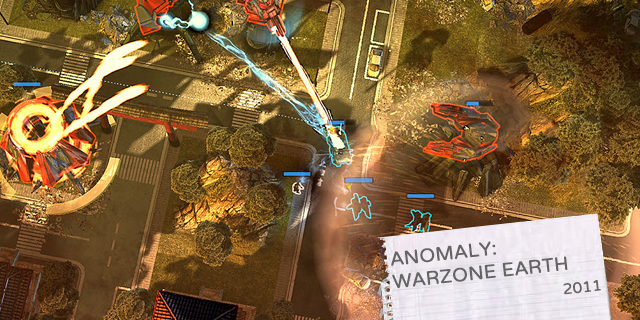
Bend it, break it and turn it around
 I wonder quite a bit what games must look like from the other side. Lord of the Rings: The Third Age and Dragon Age: Origins‘ Darkspawn Chronicles let you control enemy units, but something like Anomaly allows you to remain the good guy while turning the typical tower defense around. You’re controlling the units, setting their path and determining squad layout to best destroy and avoid enemy towers.
I wonder quite a bit what games must look like from the other side. Lord of the Rings: The Third Age and Dragon Age: Origins‘ Darkspawn Chronicles let you control enemy units, but something like Anomaly allows you to remain the good guy while turning the typical tower defense around. You’re controlling the units, setting their path and determining squad layout to best destroy and avoid enemy towers.
 It helps to expand the way people think about strategies to let them try the other side for a while and see if they can come up with better plans than the creeps they’re used to. It’s something that developers were having to do anyway, though. Even still, tower defense games seem to thrive on the enemy AI being incredibly dumb and predictable. Do you think a more intelligent creep AI could work, or does that just break things?
It helps to expand the way people think about strategies to let them try the other side for a while and see if they can come up with better plans than the creeps they’re used to. It’s something that developers were having to do anyway, though. Even still, tower defense games seem to thrive on the enemy AI being incredibly dumb and predictable. Do you think a more intelligent creep AI could work, or does that just break things?
 There is always room for more varied and more intelligent enemies. Units that sabotage powerful towers instead of trying to get to the end of the path, and units that seek out the player character (if one exists) instead of blindly marching forward? They make for a more engaging, and ultimately more rewarding, experience. They can’t be too smart though, because if the incoming units all break the rules in some way, then you lose that joyful feeling that comes from plotting out a good course and watching a plan come together.
There is always room for more varied and more intelligent enemies. Units that sabotage powerful towers instead of trying to get to the end of the path, and units that seek out the player character (if one exists) instead of blindly marching forward? They make for a more engaging, and ultimately more rewarding, experience. They can’t be too smart though, because if the incoming units all break the rules in some way, then you lose that joyful feeling that comes from plotting out a good course and watching a plan come together.
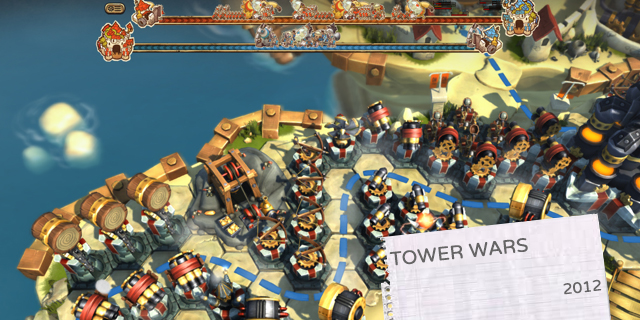
Build towers, blow up your friends
 Competitive multiplayer is seen as a way to give your game staying power, and it works. Games like Halo and Call of Duty don’t top the charts for their narrative (even if that’s why I play them). They stay popular because of well-crafted and well-balanced competitive multiplayer. Tower Wars has two opposing sides facing off by both building a maze and sending waves of units at the enemy. It’s fun, it looks good, and it brings TD back closer to RTS since you’re constantly reacting to your opponent’s strategy. This year’s Anomaly 2 takes the opposite approach and goes asymmetric. I’ll control the units while you control the towers. It sounds great on paper, but we’ve got some work to do before it’s more than a curiosity, because it’s ridiculously hard to balance.
Competitive multiplayer is seen as a way to give your game staying power, and it works. Games like Halo and Call of Duty don’t top the charts for their narrative (even if that’s why I play them). They stay popular because of well-crafted and well-balanced competitive multiplayer. Tower Wars has two opposing sides facing off by both building a maze and sending waves of units at the enemy. It’s fun, it looks good, and it brings TD back closer to RTS since you’re constantly reacting to your opponent’s strategy. This year’s Anomaly 2 takes the opposite approach and goes asymmetric. I’ll control the units while you control the towers. It sounds great on paper, but we’ve got some work to do before it’s more than a curiosity, because it’s ridiculously hard to balance.
 Asymmetric multiplayer is hard to balance no matter the context, but it’s a goal worth striving for. Even still, competitive tower defense can be a blast, like in the PSN-exclusive Comet Crash. What the genre hasn’t exactly gotten right yet is multiplayer with the traditional “think, then watch” pacing it’s most known for.
Asymmetric multiplayer is hard to balance no matter the context, but it’s a goal worth striving for. Even still, competitive tower defense can be a blast, like in the PSN-exclusive Comet Crash. What the genre hasn’t exactly gotten right yet is multiplayer with the traditional “think, then watch” pacing it’s most known for.
 I think that it could, though. Asynchronous multiplayer like Hero Academy or Ace Patrol could work in the tower defense framework. Each side has a finite amount of money to set up units or towers depending on the side. When both turns are submitted, each side watches the battle play out and formulates their next move. It could be done, and I think it could be done well. We just haven’t seen it yet.
I think that it could, though. Asynchronous multiplayer like Hero Academy or Ace Patrol could work in the tower defense framework. Each side has a finite amount of money to set up units or towers depending on the side. When both turns are submitted, each side watches the battle play out and formulates their next move. It could be done, and I think it could be done well. We just haven’t seen it yet.
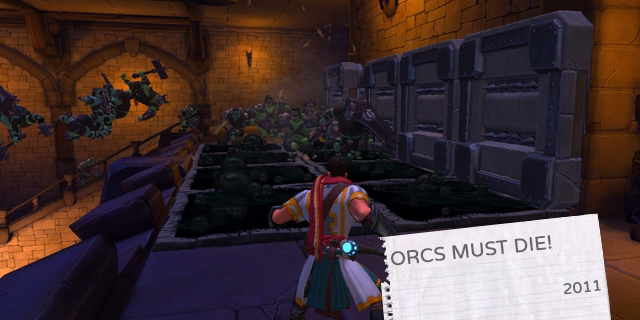
Taking part in the battle
 Genres blend and separate all of the time. Recently, everything has had some RPG injected into it. Main characters in shooters progress and gain new abilities (like in BioShock Infinite), while individual replaceable units in turn-based strategy gain experience and level up (like in XCOM: Enemy Unknown). Tower defense is borrowing from the shooter genre, though. In games like Sanctum and Orcs Must Die!, you take an active role in the defense. Shooting a weapon of your own and casting spells to complement tower damage is becoming common, and making the defense genre a much more active one.
Genres blend and separate all of the time. Recently, everything has had some RPG injected into it. Main characters in shooters progress and gain new abilities (like in BioShock Infinite), while individual replaceable units in turn-based strategy gain experience and level up (like in XCOM: Enemy Unknown). Tower defense is borrowing from the shooter genre, though. In games like Sanctum and Orcs Must Die!, you take an active role in the defense. Shooting a weapon of your own and casting spells to complement tower damage is becoming common, and making the defense genre a much more active one.
 As the tower defense genre has incorporated action elements, games in other genres have borrowed its core mechanics. Where do you draw the line? Is Iron Brigade a tower defense game? Is Starhawk? Does it matter? Should we just be happy that developers are using any ideas available to them?
As the tower defense genre has incorporated action elements, games in other genres have borrowed its core mechanics. Where do you draw the line? Is Iron Brigade a tower defense game? Is Starhawk? Does it matter? Should we just be happy that developers are using any ideas available to them?
 I don’t think it really matters. Is The Bureau: XCOM Declassified a third-person shooter? Is it an RPG? It certainly has elements of each. What we don’t need is to sit back and say “Oh that’s not a TD!,” even though you might be right. I adore Iron Brigade, but an outside observer could yell out, and be right, that it’s not tower defense. It’s influenced by the genre, and it’s fun. And at the end of the day, fun is all I’m looking for in a game.
I don’t think it really matters. Is The Bureau: XCOM Declassified a third-person shooter? Is it an RPG? It certainly has elements of each. What we don’t need is to sit back and say “Oh that’s not a TD!,” even though you might be right. I adore Iron Brigade, but an outside observer could yell out, and be right, that it’s not tower defense. It’s influenced by the genre, and it’s fun. And at the end of the day, fun is all I’m looking for in a game.
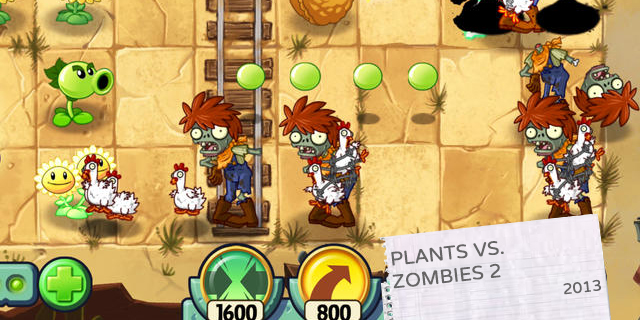
Microtransactions and you
 I abhor microtransactions, and it makes me sad to see the tower defense genre embracing it. Both of PopCap’s recent defense offerings, Plants vs. Zombies 2 and Plants vs. Zombies Adventures, hide towers behind pay walls and offer “pay to win” buttons when things get hard. It makes me constantly wonder if I’m having difficulty because my strategy isn’t up to snuff, or because I haven’t invested enough in the platform. Adventures is particularly bad about this, as after placing five towers of any given type, you start paying for them with gems, an in-game currency that can only be bought with cash. As more games move to Facebook and mobile devices and more gamers demand initial purchases at or below a dollar, I think you’ll see a worsening of the genre. I’ll give you $15 to play the game, EA. After that, you can stop looking at my wallet.
I abhor microtransactions, and it makes me sad to see the tower defense genre embracing it. Both of PopCap’s recent defense offerings, Plants vs. Zombies 2 and Plants vs. Zombies Adventures, hide towers behind pay walls and offer “pay to win” buttons when things get hard. It makes me constantly wonder if I’m having difficulty because my strategy isn’t up to snuff, or because I haven’t invested enough in the platform. Adventures is particularly bad about this, as after placing five towers of any given type, you start paying for them with gems, an in-game currency that can only be bought with cash. As more games move to Facebook and mobile devices and more gamers demand initial purchases at or below a dollar, I think you’ll see a worsening of the genre. I’ll give you $15 to play the game, EA. After that, you can stop looking at my wallet.
 Tower defense games were hit hard by this business model shift, and it’s because of how much they appeal to casual, mobile players. The roots in Flash games haven’t gone away. They’re easily controlled on a phone while commuting, or in another browser window while you’re doing other things. They’re second only to the Match-3 style subgenre of puzzle games in uniting avid players with the general public under a united banner. But I agree with you; tower defense games are inherently about puzzle-solving, and when not everyone’s working with the same puzzle pieces, it just doesn’t feel right.
Tower defense games were hit hard by this business model shift, and it’s because of how much they appeal to casual, mobile players. The roots in Flash games haven’t gone away. They’re easily controlled on a phone while commuting, or in another browser window while you’re doing other things. They’re second only to the Match-3 style subgenre of puzzle games in uniting avid players with the general public under a united banner. But I agree with you; tower defense games are inherently about puzzle-solving, and when not everyone’s working with the same puzzle pieces, it just doesn’t feel right.
 I don’t know what the right answer is here. I’m not even sure that the majority of players see it as a problem, and I can relate. It’s hard to beat the low, low price of free for a complete game, and it’s easy to justify an in-game purchase because you’re having fun and want to support the developer. And the model clearly works. If it didn’t companies like Zynga wouldn’t exist and EA wouldn’t be moving toward that model. There’s no getting around the exploitative feel of the business model. I hope that obvious cash-grabs like Plants vs. Zombies 2 finally convince people that they’re not getting a game for free; they’re giving companies a platform to ask for more money in smaller chunks than they could justify asking for altogether in a single sale.
I don’t know what the right answer is here. I’m not even sure that the majority of players see it as a problem, and I can relate. It’s hard to beat the low, low price of free for a complete game, and it’s easy to justify an in-game purchase because you’re having fun and want to support the developer. And the model clearly works. If it didn’t companies like Zynga wouldn’t exist and EA wouldn’t be moving toward that model. There’s no getting around the exploitative feel of the business model. I hope that obvious cash-grabs like Plants vs. Zombies 2 finally convince people that they’re not getting a game for free; they’re giving companies a platform to ask for more money in smaller chunks than they could justify asking for altogether in a single sale.



















